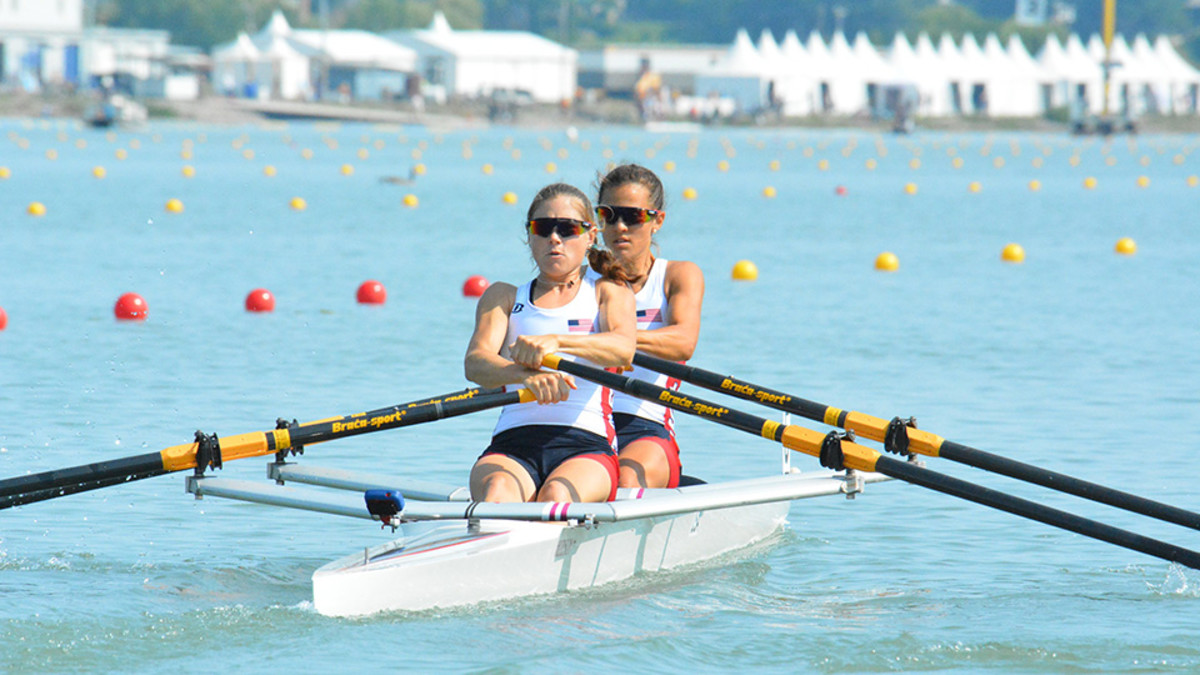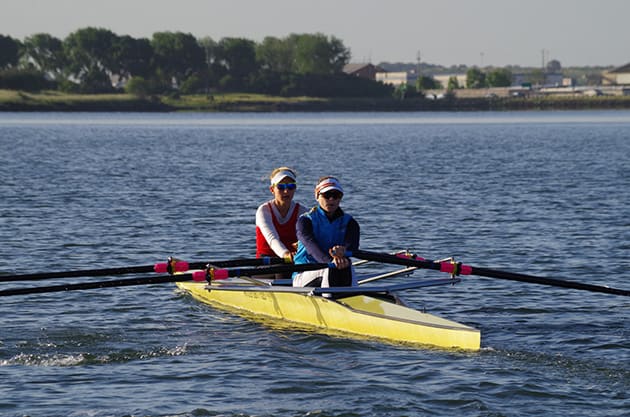Making weight: A lightweight rower's struggle with the scale
Victoria Burke’s New Year’s Resolution this January was to lose weight, 11 pounds to be exact. Standing 5’6” and weighing 133 pounds, Burke had a healthy body-mass index of 21.5 and was working out more than 20 hours a week at the California Rowing Club in Oakland, Calif. But to achieve the dream of rowing for the U.S. Olympic team in Rio this summer, Burke and her lightweight double sculling partner, Nancy Miles, have to be under a combined weight of 114 kilos (251.3 pounds). That means 129 pounds for 5’9” Miles, and 122 pounds for Burke.
She has been here before, competing as an open weight rower in college at Vermont and Virginia—she helped the Cavaliers’ varsity eight to a second place finish at the NCAA Championships in 2009—then dropping 10 pounds to race as a lightweight over her summer breaks. When she began training in earnest for this Olympic cycle last fall, losing a couple of pounds a month seemed achievable. “I thought This can’t be that bad going into this again,” she says, “but I was wrong.”
Burke, 28, weighs herself at least once a day: every morning, and sometimes after working out, or just before she heads off to sleep. “You want to get comfortable with being hungry at night,” she says. She gets her carbs from fruits and vegetables rather than processed foods like bread, and turns to low-fat protein sources like chicken, egg whites, and non-fat yogurt. Building muscle is complicated because although that might increase her power, it will also increase her weight.
Most of the time she sticks to high volume, low calorie foods. Eating a salad rather than an energy bar makes you feel more full even if both might contain the same number of calories, because the salad is physically bigger. At races that strategy flips. “The day before weigh-ins it’s really more about the actual weight of your food,” Burke says, “because that’s going to be what shows up on the scale.” And a big salad weighs more than a small energy bar.
Rare breed: An undefeated wrestling standout's intense regimen
To shave the final couple of pounds on race day, Burke will wrap herself in layers of clothing and work out on a rowing machine, sweating down to her target weight. For later starts she instead jumps in a hot shower or bath for about 15 minutes, then immediately wraps herself up in as many towels and blankets as she can find to sweat without wasting energy.
“Some days are better than others,” Burke says about the psychological challenge of restricting her diet, “and I try to warn people on the days that are not good for me.”
After graduating from Virginia in 2010, Burke moved up to the U.S. senior team. She won a silver medal with the U.S. lightweight quad at the world championships in New Zealand that fall. But she was emotionally and physically burnt out. She quit in 2011 and switched to coaching instead, first at Virginia and then UCLA.
She wouldn’t step back into a boat until 2014. Then last year she teamed up with Sarah Giancola, a rower she’d coached in the U.S. U-23 lightweight quad, to train for the Pan American Games in Toronto. They would eventually pick up a bronze in the lightweight double in Canada, but as training ramped up in the winter beforehand, Burke thought about walking away again.
The SI Extra Newsletter Get the best of Sports Illustrated delivered right to your inbox
Subscribe
“I did a lot of high intensity stuff within a two-week window, and I didn’t recover very well,” Burke says. “All of a sudden my personality shifted hard.”
****
The connection between weight and women’s sports is a sensitive subject. In 1999, researchers at the Laureate Psychiatric Clinic and Hospital in Tulsa, in collaboration with the NCAA, investigated the prevalence of eating disorders among 1,445 DI student athletes. They found that 9.2% of female athletes had a clinically significant problem with bulimia and 2.9% with anorexia, compared to approximately 0.0% of males in both cases. Faced with those statistics there is a reluctance to focus on weight. While men’s college rosters in basketball and soccer routinely state each athlete’s height and weight, women’s only advertise height. Take the four schools that played in this year’s NCAA men’s and women’s basketball tournament championship games for example. Connecticut, Villanova, Syracuse, and North Carolina all publish weights for their male players, but not for their female counterparts.
Lightweight rowing is an exception to that rule. Not only does everyone know what number a lightweight must be below to compete, but the rowers also have to strip down to their uniforms and publicly weigh-in before each race. For most lightweight rowers, that is a fair compromise. The taller a rower is, the longer their stroke, and the greater the impulse that they can apply to the boat on each drive. And coaches usually try to match heights within their crews for consistency. The shortest open weight women’s rower on last year’s U.S. national team was 5’10”, and more than half of the others were at least 6-foot. The lightweight category creates opportunities for those who have power and technical skills, if not height.
But women’s lightweight rowers check many of the risk factors for eating disorders: they are female, young, athletes, and are adept at manipulating their body weight. “There’s definitely been times when it’s messed with me mentally and I’m pretty sure that I’m not the only one that’s happened to,” Burke says. “I think I’ve been lucky to not have a full-blown eating disorder.”
The first time this happened was the summer after Burke’s freshman year at Vermont, when she dropped down from open weight to compete as a lightweight. Everyone she was training with and competing against was calorie counting, shifting her perception of what might be considered normal. “You feel like you’re leaner and more cut, and it looks good,” Burke says. Why not stay this light? she thought. I feel like I’m eating healthy.
Her dad, David, broke that spell. An amateur cyclist, David was just as competitive and just as obsessive about training as his daughter. “He and I were always trying to get a workout in, no matter where we are, or what we’re doing,” Burke says. Worried that his daughter might be restricting her diet too much, David insisted she eat more.
“There’s times when I almost touch the idea again,” Burke says of her intervening years competing nationally and internationally as a lightweight, “but then I see some pancakes, and I’m quickly redeemed.”
****
On Mar. 12, Burke got a call from her mom, June Ann. David, 63, had hit a pothole while out riding with friends, and had crashed into a guardrail. He was stable, but unconscious. Burke flew home to Connecticut. When she got to the hospital a neurologist bluntly explained that David was gone. His body was still alive, but the blood flow to his brain had been cut off for too long after the accident.
“You could tell everything was kind of slowly going, but his heart was so strong,” Burke says. “That was the hardest thing for all of us. He is obviously so healthy everywhere else, but he was just not coming back here.”
Being surrounded by family and friends at her dad’s wake and funeral put Burke’s Olympic dreams into a different light. Should I go back? she wondered. Maybe she needed to stay in Connecticut with her family. Do I have time to go back? She was still trying to cut calories, but she’d missed two weeks of training and the stress had pushed her weight back up.
With two weeks to go until the 2016 U.S. Olympic Trials in Sarasota, Fla., Burke was hovering somewhere around 126 pounds. Losing that much that quickly is a big challenge. “Everyone’s body is a little different, so some people feel really comfortable dropping four or five pounds two weeks before racing,” she says. “I don’t feel comfortable doing that. I’ve tried that before and haven’t had much success.”
Training hard can slow weight loss because muscle rebuilding processes create inflammation and increase water weight. Reduced calorie consumption can also slow a person’s metabolism as the body fights against what it perceives as starvation. But above everything, stress is Burke’s biggest enemy, inducing the production of hormones that increase appetite. Just worrying about her weight goal can be counterproductive, let alone dealing with the loss of a loved one.
But her dad had always been her biggest fan, her most committed training partner. Earlier this spring he called her up to chat about his and her iron levels. One of her favorite memories is riding the L'Alpe d'Huez section of the Tour de France route with David back in 2013. “Even if I wanted to use [his death] as an excuse, I almost can’t,” Burke says. “Oh my gosh, he would be so mad.”
In February, Burke and Miles spent 10 days in Sarasota scouting out the site of the Olympic Trials. Their first race is this Thursday, April 21. After the long training cycle, win or lose, they already have their first stop post-race planned out: a frozen yogurt shop.
“We might even have some coupons for it. We’re ready,” Burke says. “That might be one embarrassingly massive frozen yogurt cup. You’re going to want a discount on that.”









